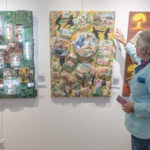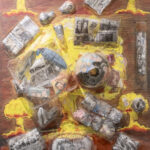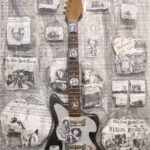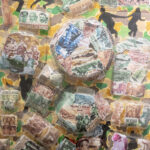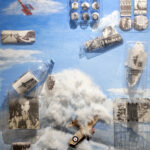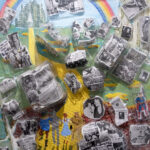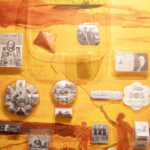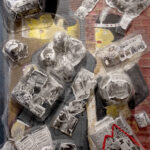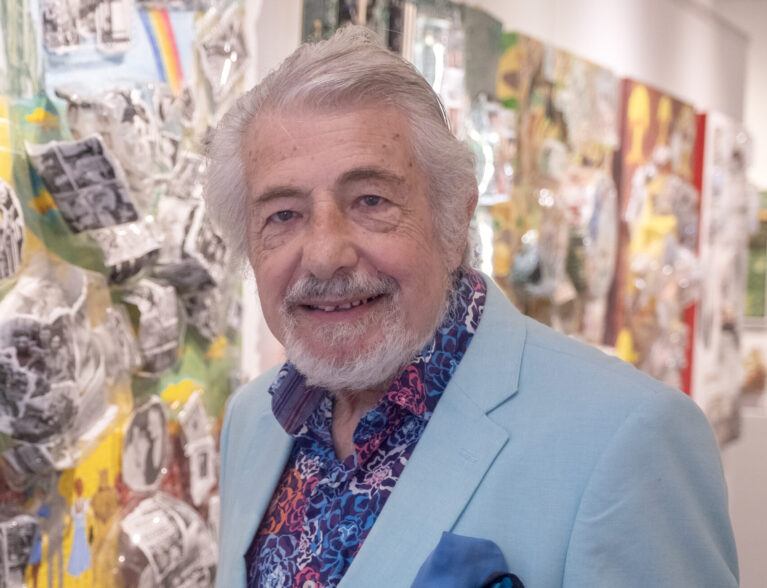
Paul Solovay brings a varied and illustrious background to his unique artwork, as featured in Journey Through the Decades: Photography and Time Capsules, on display at Gallery 14.
The show, which runs through Jan. 26, also features A Lifetime of Exploration, paintings by acclaimed artist Barbara Krupp.
Solovay earned a master’s degree from Brooklyn College, before heading into a three-decade career as a creative talent in the advertising field. He utilizes those talents in his artworks, combining a penchant for history with his photography and filmmaking skills.
The show highlights ‘Time Capsules of the 20th Century,’ a series of mixed media installations, some with sound, which focus on the momentous events and people of each decade; those whose impacts were so great they would influence that decade and beyond.
“People don’t often connect the dots,” he explains.
“Prohibition led to the Mafia’s creation, World War I led to World War II, women’s rights and civil rights. Actions in the 1920s led to going to the moon in the ’60s, and also led to the bombing of London; a continuum of how events in one decade affects the next decade, and the next decade, and the whole century,” he says, noting that each decade tells a story.
“All are mixed media, some are multi-media, having a collaged and montaged soundtrack giving you a look and sound of that decade in a very new and interesting way. I am always striving to create something new in an interesting way,” says Solovay.
The Time Capsules project took two years to accomplish, each decade requiring copious research. Each also includes collages encased in plastic, what he calls the scourge of the 20th century, as a way to recycle it artistically.
Beginning with the 1900s, Solovay highlights the introduction of flight by the Wright brothers. Depicted in ‘From Kite to Flight,’ the two brothers at Kitty Hawk are seen flying a kite, while their plane is viewed soaring above the clouds.
The 1910s show the weaponization of flight, with depictions of the Red Baron flying above a cloud formation with a British plane below. There is also the Titanic and the Romanov family, the specter of Lenin behind them.
The 1920s presents a couple entering a speakeasy during Prohibition and the organized crime it spurred, with gangsters such as Al Capone. On the financial side, a red line going down, down and off the canvas indicates the stock market crash.
Although many were still out of work in the 1930s, a rainbow indicates that the country was beginning to come out of the Great Depression.
“We were looking for some joy in our life, so I put in ‘The Wizard of Oz,’ used as a metaphor, showing Dorothy, the Tin Man, the Lion and the Scarecrow going down the yellow brick road towards the Emerald City, alongside the skyscrapers being built in New York City. New York City was like the Emerald City in so many ways,” reflects Solovay.
The wars in the Pacific and European theaters were the major events in the 1940s, so Solovay chose as the background the camouflage worn by the marines. Photographs highlight the historic meetings between Churchill, Roosevelt and Stalin, and later with Churchill, Harry Truman and Stalin, following the death of FDR.
Battle scenes relate the state of the world, as silhouettes of swing dancers overlay the camouflage, reflective of the music of the era. A soundtrack plays the Andrews Sisters singing “Boogie Woogie Bugle Boy,” interrupted by the voices of world leaders of the era.
“Everyone was testing nuclear weapons in the atmosphere in the 1950s,” says Solovay. “We didn’t realize how dangerous that was. The protest movement against that started as a result, and as children we were told to hide under our desk.”
The dichotomy of the era is presented with the “Howdy Doody Show” and “Father Knows Best” sharing space with nuclear mushroom clouds. And the same decade that brought us Rock ’n’ Roll and Elvis Presley, brought McCarthyism, the execution of Ethel and Julius Rosenberg, the Beat Generation, the start of the Civil Rights Movement, and the exodus to suburbia.
For the 1960s, Solovay concentrated on three colors – black and white to depict the height of the Civil Rights era, and red, for that decade’s violence and bloodshed.
“And yet we had the Beatles and the moon mission. The whole decade starts off with JFK’s ‘Ask not what the country can do for you – ask what you can do for your country.’ Vietnam, Twiggy and Martin Luther King shared the news with the two Kennedy assassinations,” says Solovay.
The focus of the 1970s installation is an actual electric guitar, minus the strings, “because it was the day the music died,” says Solovay. The accompanied soundtrack, ‘American Pie,’ is backed by sheet music for that song, shrouded in black veil.
The base of the guitar contains photos of musicians of the era and a clipping on the death of Elvis, while the four Beatles are, symbolically, placed separately along the neck. Nixon resigning, the chaotic withdrawal from Vietnam and the Pentagon Papers are also depicted.
Gorbachev and Ronald Reagan face off in the 1980s, with the words, “Mr. Gorbachev, tear down this wall” atop a 3-D wall at the bottom. The attempt on Reagan’s life, the murder of John Lennon, and the assassination of Sadat, as well as the start of the computer age, with Steve Jobs and Bill Gates, are also featured.
Circuit boards light up in the 1990s against a Fleetwood Mac soundtrack, as various luminaries from the period interrupt and talk over it. The era brought us the repeal of apartheid in South Africa and Nelson Mandela elected its president, the Oklahoma City bombing and the Columbine High School massacre.
The show also pulls from Solovay’s career as a jingle writer, composer and lyricist, working with some of the best musicians around, to create what he calls ‘Music Portraiture,’ explaining, “Photographs of musicians never showed their music coming through.”
Photos by Joshua Kodis
- Paul Solovay
- Paul Solovay
- Paul Solovay



